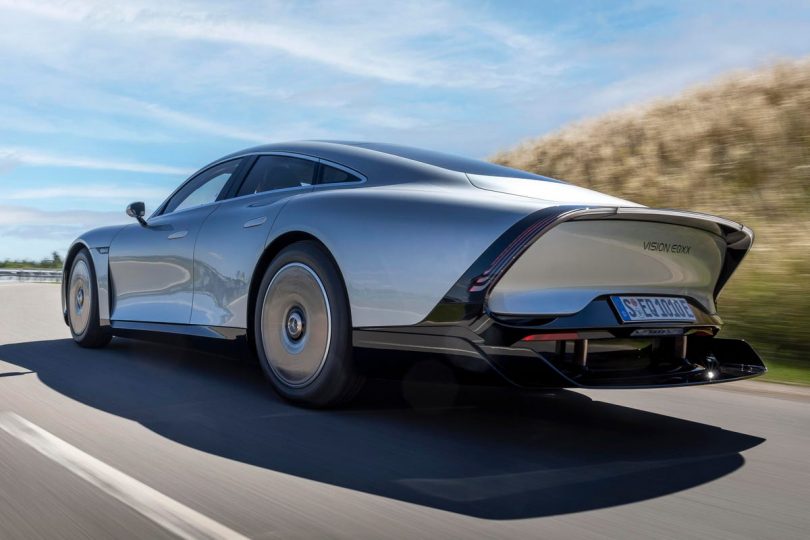Mercedes-Benz VISION EQXX Prototype
Minutes after driving a historic 1886 Benz Patent-Motorwagen, widely recognized as the world’s first practical automobile, I’m behind the wheel of the all-new VISION EQXX prototype, which is the world’s most advanced and efficient vehicle. My remarkable experience – from benzene burning to emission-free electric – is a 140-year leap of technical innovation courtesy of celebrated automaker Mercedes-Benz, which has brought me to Germany to study and drive its record-setting teardrop-shaped prototype.
The Mercedes-Benz VISION EQXX Project
The Mercedes-Benz VISION EQXX project started 18 months ago as a clean-sheet exercise demonstrating the Mercedes-Benz transformation into an all-electric and software-driven company. Offered top resources, its engineering team was tasked to build the world’s most efficient vehicle – an all-new electric sedan.
The project focused on lightweight construction, advanced battery technology, low aerodynamics, and an easy-to-use digital passenger interface to achieve the goal. While the engineers might have crafted a delicate one-off show car (most do because of limited resources), they instead chose to engineer a four-passenger road-legal sedan that was practical, comfortable and met safety standards – with minimal changes, the VISION EQXX prototype could hypothetically be produced.
The Mercedes-Benz VISION EQXX
The Mercedes-Benz VISION EQXX Chassis and Design
The world’s most efficient vehicle necessitates a lightweight chassis with an aerodynamic body. To build the structure, the engineering team chose to draw upon the world around them for inspiration – nature has honed high-efficiency long-distance travels over the ages.
A sizeable BIONEQXX aluminum alloy structural casting is buried within the body, which resembles a web-like sponge. The casting, which helps to support the vehicle’s rear, is lightweight and incredibly strong – the material is only placed where it is needed. The openings in the BIONEQXX, which needed to be sealed from moisture and dirt, were closed with UBQ Materials (a recycled, sustainable plastic substitute). Other parts (e.g., windshield wiper motor bracket) were made with BIONICAST, a term Mercedes-Benz uses to define structural castings engineered according to the principles of nature.
The body-in-white was constructed with MS1500 ultra-high strength steel and low-CO2 flat steel (produced from 100 percent scrap material). The doors were made from a hybrid of CFRP and GFRP (carbon- and glass-fiber reinforced plastics) with aluminum reinforcements – polyamide foam was used to strengthen the door frame and optimize energy absorption in a crash. Advanced materials kept the gross vehicle weight of the EQXX down to just 3,858 pounds.
The side view of the VISION EQXX shows off its low .17 Cd!
The brake rotors, traditionally manufactured from heavy cast iron, were crafted from lightweight aluminum alloy (an effective way to reduce mass considering that most braking is via regeneration). The 20-inch aerodynamic wheels are forged from featherweight magnesium. And Bridgestone Turanza Eco tires were specially crafted to be lightweight, aerodynamic (even the logos embossed on the sidewall have been optimized), and provide low rolling resistance utilizing the company’s ENLITEN and ologic technology.
EVs use about two-thirds of their battery capacity to cut through the wind on the highway. The Mercedes-Benz engineers, no stranger to streamlined vehicles, designed the VISION EQXX with a body shaped like a smooth water droplet (the rear track is narrower than the front). Body seams are tight, and the underbelly is nearly flush. The low frontal area nose features motorized cooling shutters, while the rear boasts a retractable rear diffuser. The results were impressive – the streamlined VISION EQXX boasts an astonishingly low .17 Cd (the lowest of any vehicle on the road).
The Mercedes-Benz VISION EQXX Interior
The interior impressively blends a space-age vision with luxury and sustainability – while continuing the theme of keeping mass to a minimum. The driver sits behind a three-spoke steering wheel, which is surprisingly traditional in its overall appearance. The seats are sculpted and firm, and a tubular center console separates the two front seat occupants. The primary driver and passenger interface is a massive 47.5-inch seamless display (7680×660 pixels) mounted low enough on the dashboard not to impede outward vision. Overall, the cabin is spacious and airy. Despite the lack of a sunroof (or a rear window), there isn’t even a suggestion of claustrophobia.
The interior of the VISION EQXX boasts a 47.5″ display
Passengers are surrounded by an array of unique, sustainable materials from various start-ups worldwide. For example, the door pulls are made from AMsilk’s Biosteel fiber (a high-strength, biotechnology-based, and certified-vegan silk-like fabric). One of the interior materials is MyloTM (a verified vegan leather alternative made from mycelium – the underground rootlike structure of mushrooms). At the same time, the seats are upholstered with Deserttex (an animal-free, sustainable cactus-based biomaterial made from cactus fibers). The shag carpets are crafted from 100 percent bamboo fiber, and recycled PET bottles are used in a shimmering textile to enhance the floor area and door trim. The EQXX interior also features UBQ material (a sustainable plastic substitute made from household and municipal landfill waste) and Dinamica (made from 38 percent recycled PET).
The engineers at Mercedes-Benz went over the top with the infotainment, data streaming, and user interface (UI) technology inside the EQXX (I could dedicate a few more thousand words to the technology). Nearly all of it interacts via the colossal screen at the front of the cabin. And don’t worry about the screen consuming too much power – the mini-LED backlight utilizes more than 3,000 local dimming zones to ensure electricity is only required when specific screen sections need to be illuminated.
Mercedes partnered with the artificial intelligence experts at BrainChip to develop an interface that runs spiking neural networks (information is coded, so energy is only consumed when needed). And « Hey Mercedes » utilizes neuromorphic computing, so responses are generated and delivered on-demand, versus pre-recorded and played (the engineers say this is up to 10 times more efficient than traditional systems). Another eye-opening feature is the 3D navigation system, part of a joint effort with NAVIS Automotive Systems, which allows the user to zoom from a satellite view to a height of 33 feet above the road surface. As expected, the infotainment system follows the current Mercedes-Benz Zero Layer concept that simplifies the interface by reducing menus and keeping pertinent information on the screen.
A closer look at the 7680×660 pixel main display in the VISION EQXX
The Mercedes-Benz VISION EQXX Battery and Powertrain
Mercedes-Benz developed a new battery pack for the VISION EQXX that delivers an energy density close to 400 Wh/l. It packs about 100 kWh of usable energy in a space nearly half the size of other EV battery packs and about 30 percent lighter. The engineers also chose to use an electrical architecture of 920 volts, which allowed them to use thinner (and lighter) wiring. The battery, which utilizes active cell balancing, is contained with other crucial electrical and electronic (EE) components in what Mercedes calls the OneBox – the package weighs about 1,091 pounds.
The VISION EQXX employs an advanced battery thermal management system that uses a cooling plate on the vehicle floor (think of it like the heat sink on a computer CPU) to draw heat off the battery and transfer it to the atmosphere without any fans or electrical requirements – the act of driving forces the air over the cooling plate. The system is so effective that the sedan only needs to open its motorized aero shutters, coolant valves, and water pumps when the EQXX is operating in hot temperatures or under heavy loads. A simple, lightweight heat pump is used to heat and cool the passenger cabin in place of a heavy air conditioning compressor and condenser.
The VISION EQXX’s retractible rear diffuser extends at high speeds
A keen observer will note the roof of the EQXX is covered with 117 solar panels developed in cooperation with the Fraunhofer Institute for Solar Energy Systems ISE. The energy captured from the sun is stored in a separate lithium-ion phosphate battery. It is used to power ancillary systems (e.g., climate blower, lights, infotainment system), thereby preserving 100 percent of the energy in the main battery for propulsion. (By reducing the workload of the primary battery, the roof panel can add up to 15 miles of range on a long journey.)
Power from the main battery is sent to an electric motor on the rear axle that drives the rear wheels through a single-speed gearbox. The maximum power output from the motor is 180 kW (or 241 horsepower).
How Does the Mercedes-Benz VISION EQXX Drive?
The VISION EQXX drives surprisingly well for a one-off prototype, especially compared to the dozens of others I have driven over the years. There are no annoying compromises (e.g., uncomfortable seating position), half-baked technologies (e.g., only some of the dashboard buttons work), or mechanical limitations (e.g., the front wheels rub against the bodywork when turned too far). Instead, I can operate it without restriction – precisely as I would any other vehicle in the current Mercedes-Benz lineup.
The sleek VISION EQXX at speed
My 10-mile test route is within the closed confines of the company’s massive test center in Immendingen, Germany. The two-lane evaluation road included corners, straights, roundabouts, and high-speed sections – a proper mix that allowed me to observe how the EQXX reacted dynamically to my driver inputs and the elevation changes.
Similar to the Mercedes-Benz EQ-Series, the VISION EQXX allows the driver to alter the regenerative force with the steering wheel-mounted paddles (the left paddle increases regeneration drag while the right paddle decreases it). The most robust mode (« D- -« ) allows effective « one-pedal » driving. An adept driver focusing on efficiency will actively use the paddles while driving to recuperate inertial energy, thus minimizing the need to apply the mechanical brakes (where the energy is lost as heat).
Acceleration is leisurely off the line by most automotive standards, yet it’s quicker than the typical combustion-powered economy car. Moreover, power appears to come on stronger once the vehicle is rolling. My professionally calibrated derrière says there’s a sweet spot between 35 and 65 mph where the electric motors feel particularly strong – perfect for maintaining cruising speeds up hills or long grades.
The low drag coefficient drastically alters how the vehicle is driven in terms of accelerator usage. Lift off the pedal, and the VISION EQXX glides along seemingly without resistance. If the road slopes downward, even a single degree, the vehicle will pick up speed. I noticed myself spending more time attempting to bleed off speed than trying to add speed – quite the opposite of how every other vehicle – electric or combustion – is driven. (Mercedes-Benz has not tested the vehicle’s top speed, but my guess is that it will top an impressive 200 mph based on its low drag and power.)
The author, Michael Harley, behind the wheel of the VISION EQXX
As is typical of most electric vehicles, the VISION EQXX boasts an impressively low center of gravity that considerably reduces body roll. Combined with its low mass, the driving dynamics feel delightfully energetic. As a result, the EV is agile, and its handling and responsiveness inspire confidence around corners and while negotiating traffic circles (even at elevated speeds). I was very proactive with the regeneration paddles, so I barely had to touch the brakes – driving the EQXX precisely as its engineers intended.
The ride is best described as sporty – firm but never abusive. The low rolling resistance pneumatic tires are running 50 psi, which limits their fundamental cushioning ability. The suspension damping is not adjustable, and there’s an absence of high-tech wizardry in engineered underpinnings (e.g., there is no 48-volt air suspension system like the S-Class), but the ride is comfortable – I’d drive it coast-to-coast across the United States without protest. On that note, the interior is surprisingly quiet at speed. Very little wind noise permeates the passenger cabin (the tires rolling over the asphalt aggregate is the loudest part of the ride).
The VISION EQXX drives just like any other premium EV, and it doesn’t require considerable skill to operate the VISION EQXX efficiently. Driving with smooth inputs, anticipating the acceleration and braking zones in advance, and using the regeneration paddles astutely will deliver impressive mileage from each electron – the vehicle is so naturally efficient that an amateur could set range records. In case anyone is keeping score, the engineers told me that I was able to squeeze 8.17 miles per kWh over my 10-mile drive (a Tesla Model 3, which is one of the most efficient vehicles on the road, can deliver only about 4.4 miles per kWh). So, in theory, I could have driven 800+ miles at that pace!
The 1886 Benz Patent-Motorwagen next to the VISION EQXX prototype — the past and the future
The Future of the Mercedes-Benz VISION EQXX
Early this summer, the engineering team took the completed VISION EQXX prototype onto public roads and drove from Sindelfingen, Germany, to Cassis, France, on a single charge – setting a distance record of 626 miles over 11 hours and 32 minutes. A few weeks later, the team aimed the vehicle west and drove from Stuttgart, Germany, to Silverstone, England, on a single charge – covering an extraordinary 746.8 miles.
Engineering the world’s most advanced, innovative, and efficient vehicle is costly (the process isn’t a palatable undertaking by most automakers). Yet Mercedes-Benz is a company that consistently believes that breaking through technological barriers and expanding the boundaries of current invention is valued – the creation and trials allow the company to build safer, more efficient, and luxurious consumer automobiles. As a result, the EQXX’s countless engineering « firsts » will find themselves commonplace on upcoming Mercedes-Benz vehicles, just like airbags and anti-lock brakes.
The VISION EQXX prototype was crafted as a one-off halo car for an all-electric future, so it will eventually find its resting place in the expanding galleries of the Mercedes-Benz Classic Center Museum. But in the meantime, I’m betting the sleek sedan still has a few more records to set.








